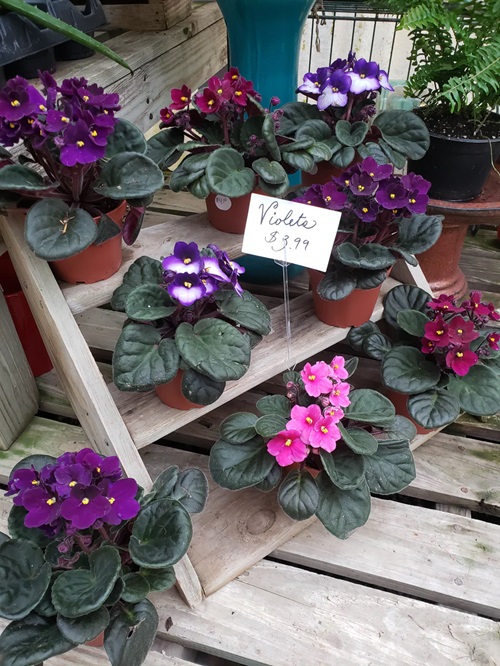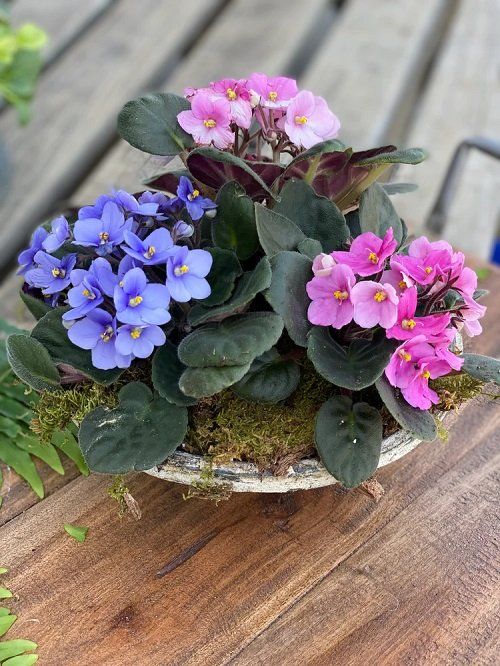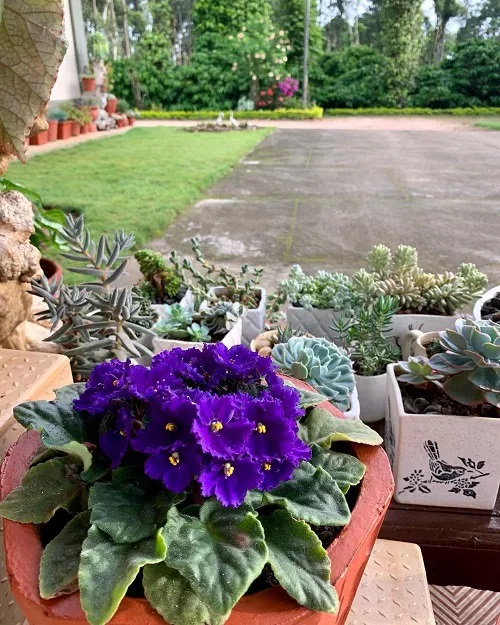African Violets are superb houseplants that flourish indoors! But is growing them outdoors too much work? Let’s find out!

African violets have stunning velvety blooms in an explosion of colors and patterns. More popular in the 60s, they are making a comeback as chic and vintage houseplants that thrive indoors!
Perhaps you wonder if they can grow outside with the same vigor but have seen mixed reviews that are confusing you. Find your answers in this guide!
Can African Violets Grow Outside
In theory, if you can replicate their ideal growing conditions outdoors, there’s no reason why they wouldn’t survive there. But how well can one do this, and what are these “ideal growing conditions?”
Before we get into their needs, it’s important to note that the only wild they are found in is a tiny biodiverse spot in Tanzania threatened by deforestation. While popular as indoor houseplants, these floral divas are quickly going extinct in nature!
So, why do we call them divas? Despite their resemblance to violets and the name, these plants belong to an entirely different genus—Saintpaulia—which is shockingly sensitive to fluctuations in temperature, light, humidity, and water.
Native to the tropical climes of Tanzania and Kenya in eastern Africa, saintpaulias are hardy to USDA Zones 11-12 and thrive in mild temperatures of 60-80 F (15-26 C). They grow well in warmth, dappled sunshine, and consistent watering. But let’s dig into the details.
What do African Violets Need to Thrive?
Beneath the forested canopies of their native habitat, plenty of shade, filtered sunshine, humidity, and constant weather and conditions enable them to flourish. They grow well outdoors in Tanzania or in places with similar growing conditions.
But it’s obviously difficult to replicate massive tropical trees and identical ecosystems in North America’s continental and temperate climes. This is the main reason why African violets thrive indoors but bomb outdoors.
However, gardeners have successfully created suitable microclimates using greenhouses and other means to grow African violets outdoors in contrasting regions.
By providing these floral belles the care they need, you can enjoy perpetual year-round blooms, with some living up to 50 years!
Ideally, African violets prefer daytime temperatures of 70-90 F (21-32 C) and a nighttime range of 65-70 F (18-21). They cannot withstand prolonged periods outside these ranges, so if your outdoor temperatures dip or rise sharply, they won’t survive. If you can maintain consistency in the temperature, they would.
This plant also requires protection from direct sunshine. Its delicate leaves and petals can scorch under overexposure. It also needs humidity of 40-60% to thrive. These specifics are easy to simulate indoors, using humidifiers, grow lights, filtered sheer curtains, etc.
Keeping it in cozy spots like bathrooms and kitchens or placing the pot in a tray filled with water and gravel helps with the humidity. Also, rotating saintpaulia regularly so all parts receive dappled sunshine uniformly helps the plant grow evenly and look its prettiest.
Can African Violets Grow Outdoors Partially?
If you want to keep your plant outside to provide fresh air and joyous sunshine, ensure perfect conditions. Do not place it in direct sunlight; move it indoors before the temperature falls below 65 F. You can also keep it in the vicinity of several plants together to provide a microclimate.
It hates wet feet, so don’t expose it to rainfall and avoid overhead watering. Instead, directly target its roots to hydrate efficiently by bottom watering. This plant is so sensitive that water that’s too cold may strip the color of its petals, and too hot could damage its leaves! And it doesn’t like misting either.
Pruning faded flowers, and deadheading ensures prolific blooms. If your African violets aren’t producing blooms or have pale leaves, it’s a sign that the plant isn’t getting proper nourishment or that pests are bugging it. Supplement it with a phosphorous-rich fertilizer and examine it closely for pests and don’t forget to read this article.
In conclusion, you could try growing African violets outdoors if you can promise to keep everything steady. Perhaps a shade garden with ample humidity, compost-rich, well-draining soil, and part sun works.
However, growing them in containers is ideal and safeguards your plant from the risks of sudden fluctuations. If and when conditions change, you can quickly move this delicate flower to its safe and happy space!




